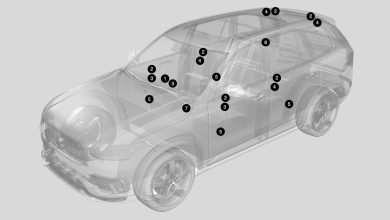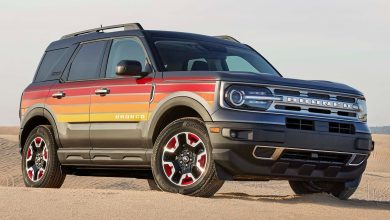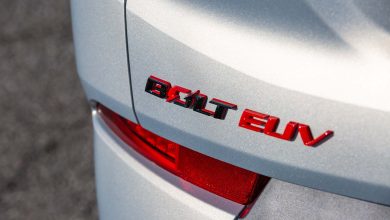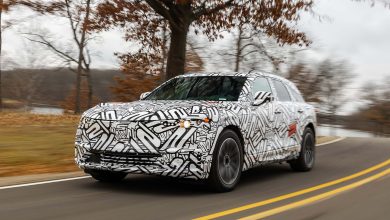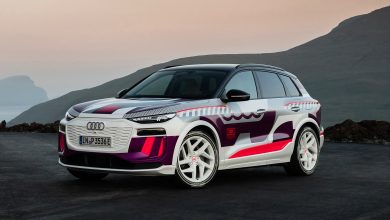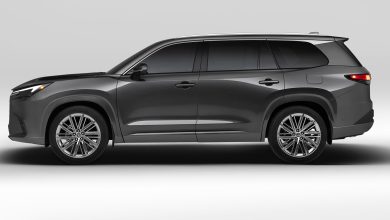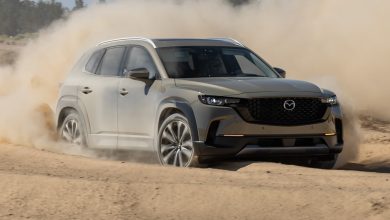2024 Hyundai Kona First Look: Bigger, More EV-Focused Than Before

For Hyundai, the tiny Kona is a big deal. The automaker gave us our first peek and a smattering of details of the second-generation Kona in December, showing off an edgy and slightly quirky new design for the already edgy and slightly quirky subcompact SUV. Now we’ve gotten our first up-close, in-person look at the 2024 Hyundai Kona at its world debut.
The cheap and cheerful crossover won fans by driving like a tall hatchback, though it was hampered by a cramped second row and small cargo hold. Hyundai addresses both shortcomings with a longer wheelbase, adding a couple of inches to the distance between the new Kona’s axles, making it now one of the larger offerings in the B-segment.
The second generation offers an opportunity to give the Kona more aggressive styling, more advanced technology, and more room inside. The 2024 Kona is about six inches longer and slightly wider, with a rear opening that is both taller and wider. It also looks markedly different than its predecessor, with the Seamless Horizon Lamp (full-width LED unibrow) and being both distinctive and firsts for Hyundai. The front-end design mimics that of the Hyundai Staria van sold overseas, but without any cutlines. Hyundai Motor Group Executive Vice President and Head of Hyundai and Genesis Global Design Centre SangYup Lee did not want a traditional front end because the all-electric variant will lead the new Kona family.
Making Kona Electric The Priority Changes Everything
Hyundai reversed the normal development process in which a new model starts with internal combustion engine (ICE) versions and later adds an EV variant, which results in a shorter lifecycle for the electric iteration and compromises its design and packaging. So for this second-gen Kona, the Kona EV took priority over the others, which were adapted from it, not the other way around.
To help the EV out a little, the 2024 Kona was designed and engineered with a greater emphasis on aerodynamics—going from a drag coefficient of 0.29 to 0.27, which should make it a segment leader. But the SUV also gained weight, so driving range (even with the slipperier shape) is expected to be little changed from the outgoing Kona EV.
The EV has body color wheel arches (they are a contrasting dark gray on the ICE models), a black line along the bottom, and chrome molding that runs along the beltline and kicks up, hockey stick-style, to meet the rear spoiler. The body is notable for its sharp crease lines and wheel sizes that increase from 18 inches in diameter to 19. Interestingly, there are no plans for a panoramic sunroof, but the new generation has a flat floor; 30 percent slimmer front seats to provide more legroom to those seated in the second-row bench seats; mesh headrests of a breathable material; and uses bio leathers and suedes. The focus of the minimalist interior are the two 12.3-inch displays, which live under a single piece of glass, so you might not immediately notice unusual details such as the gearshift on the steering wheel (which frees up more open storage space in the center console). There is a very small frunk in front, with enough space to store charging cables but little more.
The Case for Old Bones
The 2024 Kona carries over the same powertrains and K3 platform as the current crossover. The architecture is versatile enough to support an internal combustion engine, hybrid, and battery-electric SUV, and the decision to keep using the existing bones will help keep costs down, even for the EV, says Lee.
North America will get most, but not all, of the planned variants. The choices include the regular Kona, which is currently offered with a slightly anemic 147-hp, 132-lb-ft 2.0-liter four-cylinder or a 1.6-liter turbo I-4 making 195 hp and 195 lb-ft of torque, enough to scoot a Kona N Line trim from 0-60 mph in 7.3 seconds in our testing. We don’t expect much change in the specs, but specific U.S. details won’t be fully released until the New York auto show in April, when we will learn if engineers were able to coax any more power from the current engines. All-wheel drive will continue to be offered with the internal-combustion-engine models.
No Hyundai Kona N Yet
The U.S. will continue to get similar trims of gas-powered Konas, including the sporty N Line, but there will not be a high-performance N—at least not initially. Senior vice president and head of EV Strategy Business Division Sang Hyeon Park tells us is it “under consideration.” In 2021 the Kona became Hyundai’s first SUV to get the N performance designation in a variant with a 2.0-liter turbo-four generating 276 hp and 289 lb-ft for a 0-60 sprint in 5.3 seconds. It can easily be replicated in the second generation and Park says Hyundai will add it if demand appears to be there—which we sure hope for, given how the smaller Veloster N hot hatch was recently killed off in favor of the Kona N and four-door Elantra N sedan.
What about an N version of the Kona EV? The automaker will gauge demand for the Hyundai Ioniq 5 N that is coming in the second half of the year. Adding a second motor could create an electric Kona N and Park says they are considering dual motors as a future option, again depending on demand in each market. As for the Kona hybrid, it is not offered in North America now, nor will it be offered with the new model. The focus is on the pure EV.
Not Exactly Cutting Edge
The Kona Electric has been offered alongside the ICE version since 2019 and will continue to have a 65.4-kWh battery and front-mounted 160-kW motor to generate 201 hp and 291 lb-ft of torque. Other markets get a smaller battery option. Among the new features is one-pedal driving mode. Sadly, quicker charging isn’t on the menu—the Kona will continue to be one of the slower-charging models on the market with its 400-volt system lagging behind more cutting-edge dedicated EVs such as Hyundai’s own 800-volt, 2023 SUV of the Year-winning Ioniq 5. It will therefore require about 41 minutes to charge from 10 to 80 percent with a DC fast charger. Park says Hyundai will continue to work to develop technology to lower charging times and future over-the-air updates could improve charge times in the future. We expect the driving range figure to land around 260 miles, though the EPA rating has not been finalized.
Moving to the automaker’s E-GMP dedicated electric vehicle platform (the one used by the Ioniq 5) is the ultimate goal for the Kona, but that will also make it more expensive in a segment is price sensitive and at a time when affordability of EVs in general is an issue. Keeping the EV on the K3 platform provides a more affordable EV that is still capable, Lee says. After all, the Kona EV accounts for seven percent of the sales mix, but that number is expected to increase with the new model.
Isn’t It Ioniq? Not Yet
Because the SUV Kona does not migrate to E-GMP yet, the Kona keeps its name and does not join the Ioniq sub-brand. The expectation is the third-generation Kona will make the move at which point it could be renamed. Hyundai has 11 EVs planned by 2030 in a bid to become the electric vehicle leader.
Global production begins in March for the European market, followed in April by the hybrid. Americans will see their version in April at the New York auto show and it will start arriving in showrooms in the fall. All Konas for North America will come from Korea and we should see them in showrooms in late September or early October.
We expect pricing to range from $24,000-$33,000 for the models with combustion engines, and for the Kona Electric to start about $35,000.
Read the full article here


